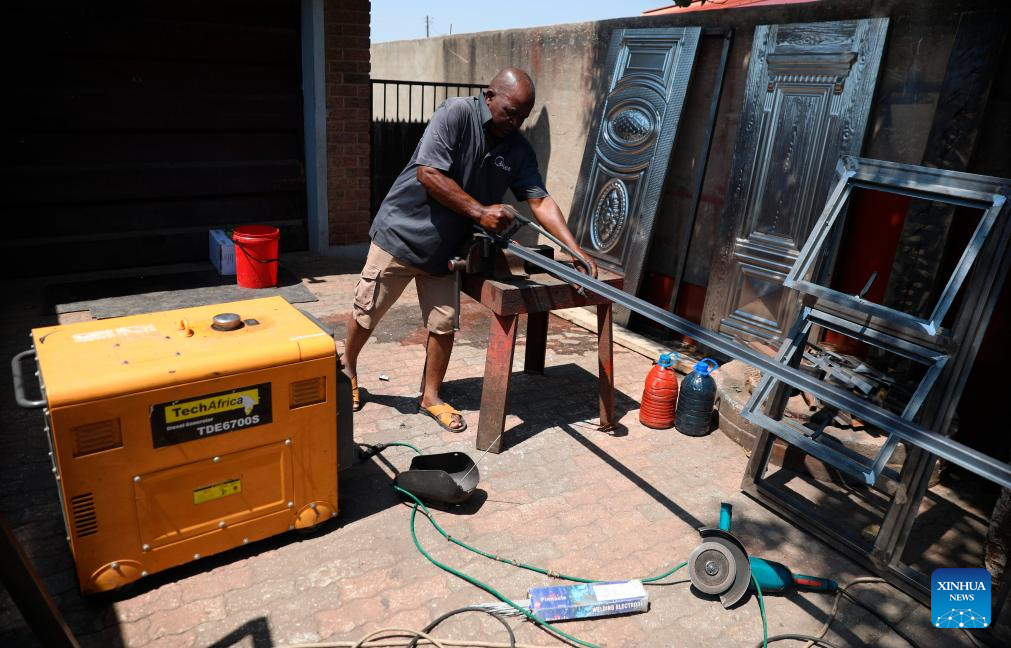
Zimbabwean welder Ngwarayi Mushaurwa works at home using a diesel generator in Harare, Zimbabwe, on Sept. 25, 2024. (Photo by Shaun Jusa/Xinhua)
HARARE, Sept. 25 (Xinhua) -- Each time power cuts disrupt his work, Ngwarayi Mushaurwa resorts to cranking up a diesel generator to keep his welding business running.
Making ends meet in Ruwa, a town southeast of Zimbabwe's capital Harare, Mushaurwa is not alone in facing rising operational costs due to frequent electricity outages. A prolonged drought has lowered water levels at Lake Kariba, home to the Kariba South Power Station, significantly impacting electricity generation at the country's main hydropower facility.
Meanwhile, aging equipment at the Hwange Power Station, the country's primary thermal plant, has worsened the rolling blackouts that can last up to 15 hours in some regions.
On average, Zimbabwe produces less than 1,300 MW of electricity, falling short of its peak national demand of about 1,950 MW. For Mushaurwa, this shortage translates into higher costs of using alternative power sources, a burden also felt by consumers.
"We use generators, but it becomes difficult to convince the clients to accept increased charges to cover fuel costs. It then becomes difficult for small businesses to be sustainable, so we are appealing to authorities to address the power deficiency so that we can sustain our families," Mushaurwa told Xinhua on Wednesday.
While generators help the 60-year-old Zimbabwean keep his business afloat, they are insufficient to drive growth. "There are some heavy-duty machines that cannot be operated with generators, so power cuts are a huge challenge," Mushaurwa said.
Unlike major corporations, small and medium enterprises (SMEs) and informal businesses lack the financial means to invest in generators or other alternative energy sources during the blackouts.
"Right now a lot of businesses are grappling with power issues because of the power outages," said Delight Makotose, director of the SMEs International Expo, an annual exhibition that seeks to create synergies and a networking platform for small and medium businesses.
"SMEs need reliable power. Procuring generators is not cost-effective, so we urge the government and energy providers to step up and ensure enough power supply," he said. Makotose expressed his concern that frequent power cuts are hampering the competitiveness of local businesses.
According to a 2023 World Bank report, Zimbabwe's power shortages are estimated to cost the country a total of 6.1 percent of its gross domestic product annually.
Medium-term World Bank projections indicated that electricity demand will grow from 1,950 MW in 2022 to 5,177 MW by 2030, driven primarily by increasing demand from the mining sector.
In response, Centragrid, a local independent power producer, is tapping into solar energy to help bridge the gap. Chief Executive Officer of Centragrid Victor Utedzi said solar is expected to play a major role in Zimbabwe's power generation to feed the increasing energy demand.
"As Centragrid ourselves right now we have got a portfolio of the large commercial and industrial clients in the mining sector -- ferrochrome, iron and steel -- we are developing large-scale solar power projects to the tune of 100-200 MW to be able to give them power during the day," Utedzi said.
Over the past few years, Zimbabwe has made strides to increase power generation capacity. In 2018, China's Sinohydro completed the expansion project of the Kariba South Power Station, increasing its capacity from 750 MW to 1,050 MW.
Last year, the same contractor completed the expansion of the Hwange Thermal Power station, adding 600 MW to the coal-fired power station.
Looking ahead, Mushaurwa remains hopeful that the power shortages will be resolved, allowing his business to thrive once more. ■



